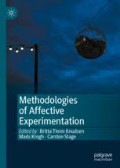Abstract
This chapter contributes to affective and new materialist experimentation with methods through a focus on two workshops with teenage girls in which they collaged imaginations of futures, where glitter emerged as an especially significant material. The chapter considers the collaging workshops in terms of a method of worlding, arguing that methods are one way worlds are, and might be, made. It highlights the future-orientation of worlding, arguing that this requires us, as researchers, to consider the politics and ethics of worlding. It explores worlding by detailing what glitter does, both to me and to the participants, and suggesting that glitter functions to open up the possibilities of the future through how it cultivates capacities for enchantment and wonder for the participants. It concludes by drawing out from the specificities of glitter and these workshops to tentatively propose what a wider engagement with an experimentation with worlding might involve.
Access this chapter
Tax calculation will be finalised at checkout
Purchases are for personal use only
Notes
- 1.
Ofsted carry out regular inspections of schools, and their judgements and reports form the basis of school league tables. I cannot cite the Ofsted report here as my institutional ethical approval requires the school to remain anonymous.
- 2.
On glitter, naivety and foolishness, see also Coleman and Osgood (2019).
- 3.
- 4.
- 5.
I also often feel anxious that I do not really address the harms that glitter has on the natural environment, focusing rather on how worlding complicates the boundaries between ‘nature’ and ‘artificial’.
References
Barad, K. (2007). Meeting the Universe Halfway: Quantum Physics and the Entanglement of Matter and Meaning. Duke University Press.
Barrett, E., & Bolt, B. (Eds.). (2012). Carnal knowledge: Towards a ‘new materialism’ through the arts. I.B. Tauris.
Bennett, J. (2001). The enchantment of everyday life. Princeton University Press.
Bennett, J. (2010). Vibrant matter: A political ecology of things. Duke University Press.
Coole, D., & Frost, S. (eds.) (2010). New Materialisms: Ontology, Agency, and Politics. Durham: Duke University Press.
Coleman, R. (2008). ‘Things that stay’ feminist theory, duration and the future. Time and Society, 17(1), 85–102.
Coleman, R. (2009). The becoming of bodies: Girls, images, experience. Manchester University Press.
Coleman, R. (2017). A sensory sociology of the future: Affect, hope and inventive methodologies. The Sociological Review, 65(3), 525–543.
Coleman, R. (2020). Glitterworlds: The future politics of a ubiquitous thing. Goldsmiths Press.
Coleman, R., & Osgood, J. (2019). PhEMaterialist encounters with glitter: The materialisation of ethics, politics and care in arts-based research. Reconceptualising Education Research Methodology, 10(2–3), 61–86.
Coleman, R., Page, T., & Palmer, H. (Eds.). (2019). Feminist new materialist practice: The mattering of method. MAI: Feminism and Visual Culture, (4). Retrieved December 17, 2021, from https://maifeminism.com/issues/focus-issue-4-new-materialisms/
Coleman, R., & Ringrose, J. (Eds.). (2013). Deleuze and research methodologies. Edinburgh University Press.
Donaldson, K., & Kontturi, K.-K. (2019). Feminist Colour-IN: An aesthetic activism of connection and collectivity. MAI: Feminism and Visual Culture, (4). Retrieved December 17, 2021, from https://maifeminism.com/feminist-colour-in-an-aesthetic-activism-of-connection-and-collectivity/
Grosz, E. (Ed.) (1999). Becomings: Explorations in Time, Memory, and Futures. Cornell University Press.
Grosz, E. (2010). The untimeliness of feminist theory. NORA: Nordic Journal of Feminist and Gender Research, 18(1), 48–51.
Haraway, D. (1988). Situated knowledges: The science question in feminism and the privilege of partial perspective. Feminist Studies, 14(3), 575–599.
Haraway, D. (2013). SF: Science fiction, speculative fabulation, string figures, so far. Ada: A Journal of Gender, New Media & Technology, 3. https://adanewmedia.org/2013/11/issue3-haraway/
Haraway, D. (2016). Staying with the trouble: Making kin in the Chthulucene. Duke University Press.
Hickey-Moody, A. (2013). Youth, Arts, and Education Reassembling Subjectivity through Affect. London: Routledge.
Hickey-Moody, A., & Page, H. (Eds.). (2015). Arts, pedagogy and cultural resistance: New materialisms. Rowman and Littlefield.
Hunter, V., & Palmer, H. (2018). Worlding: In a new materialist almanac. Retrieved December 17, 2021, from https://newmaterialism.eu/almanac/w/worlding.html
Jungnickel, K. (Ed.). (2020). Transmissions: Critical tactics for making and communicating research. MIT Press.
Kearney, M. C. (2015). Sparkle: Luminosity and post-girl power media. Continuum, 29(2), 263–273.
Knudsen, B. T., & Stage, C. (Eds.). (2015). Affective methodologies: Developing cultural research strategies for the study of affect. Palgrave Macmillan.
Kontturi, K.-K. (2018). Ways of following: Art, materiality, collaboration. Open Humanities Press.
Law, J., Savage, M., & Ruppert, E. (2011). The double social life of methods. CRESC Working Paper, 95.
Law, J., & Urry, J. (2004). Enacting the social. Economy and Society, 33(3), 390–410.
Lury, C. (2018). Introduction: Activating the present of interdisciplinary methodologies. In C. Lury, R. Fensham, A. Heller-Nicholas, S. Lammes, A. Last, M. Michael, & E. Uprichard (Eds.), The Routledge handbook of interdisciplinary research methods (pp. 1–26). Routledge.
Lury, C., & Wakeford, N. (Eds.). (2012). Inventive methods: The happening of the social. Routledge.
Lyon, D., & Carabelli, G. (2016). Researching young people’s orientations to the future: The methodological challenges of using arts practice. Qualitative Research, 16(5), 430–445.
MacLure, M. (2013). Classification or wonder? Coding as an analytic practice in qualitative research. In R. Coleman & J. Ringrose (Eds.), Deleuze and research methodologies (pp. 164–183). Edinburgh University Press.
Manning, E. (2016). The minor gesture. Duke University Press.
McRobbie, A. (2009). The aftermath of feminism: Gender, culture and social change. Sage.
Nyong’o, T. (2019). Afro-Fabulations: The queer drama of Black life. New York University Press.
Renold, E., & Ringrose, J. (2019). Jarring: Making phematerialist research practice matter. MAI: Feminism and Visual Culture, (4). Retrieved December 17, 2021, from https://maifeminism.com/introducing-phematerialism-feminist-posthuman-and-new-materialist-research-methodologies-in-education/
Stewart, K. (2007). Ordinary Affects. Duke University Press.
Author information
Authors and Affiliations
Corresponding author
Editor information
Editors and Affiliations
Rights and permissions
Copyright information
© 2022 The Author(s), under exclusive license to Springer Nature Switzerland AG
About this chapter
Cite this chapter
Coleman, R. (2022). Worlding with Glitter: Vibrancy, Enchantment and Wonder. In: Timm Knudsen, B., Krogh, M., Stage, C. (eds) Methodologies of Affective Experimentation. Palgrave Macmillan, Cham. https://doi.org/10.1007/978-3-030-96272-2_8
Download citation
DOI: https://doi.org/10.1007/978-3-030-96272-2_8
Published:
Publisher Name: Palgrave Macmillan, Cham
Print ISBN: 978-3-030-96271-5
Online ISBN: 978-3-030-96272-2
eBook Packages: Literature, Cultural and Media StudiesLiterature, Cultural and Media Studies (R0)

